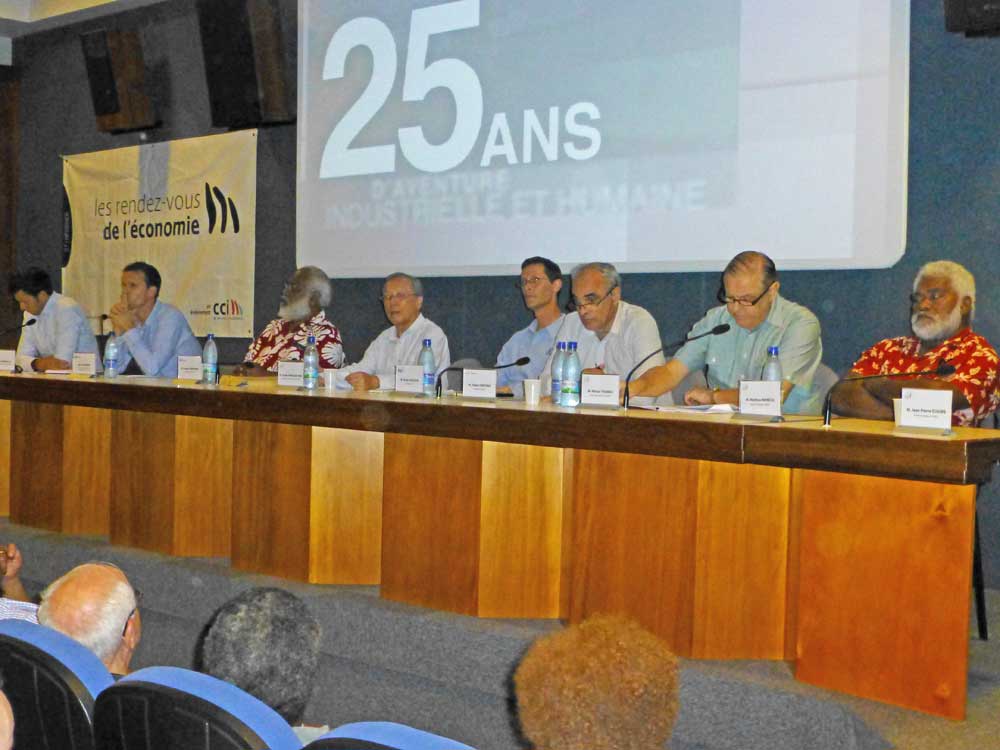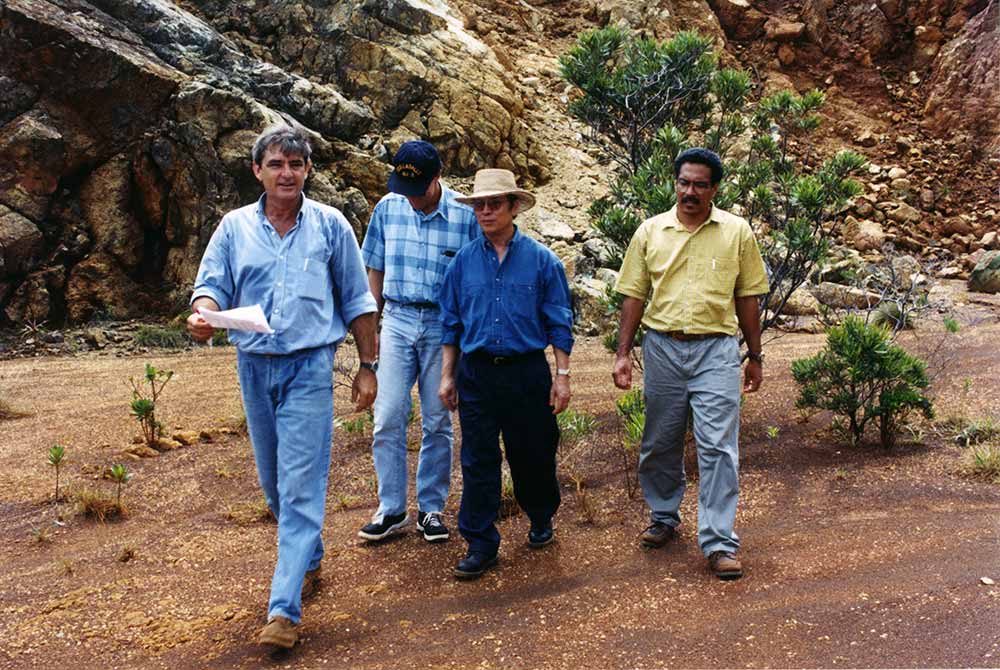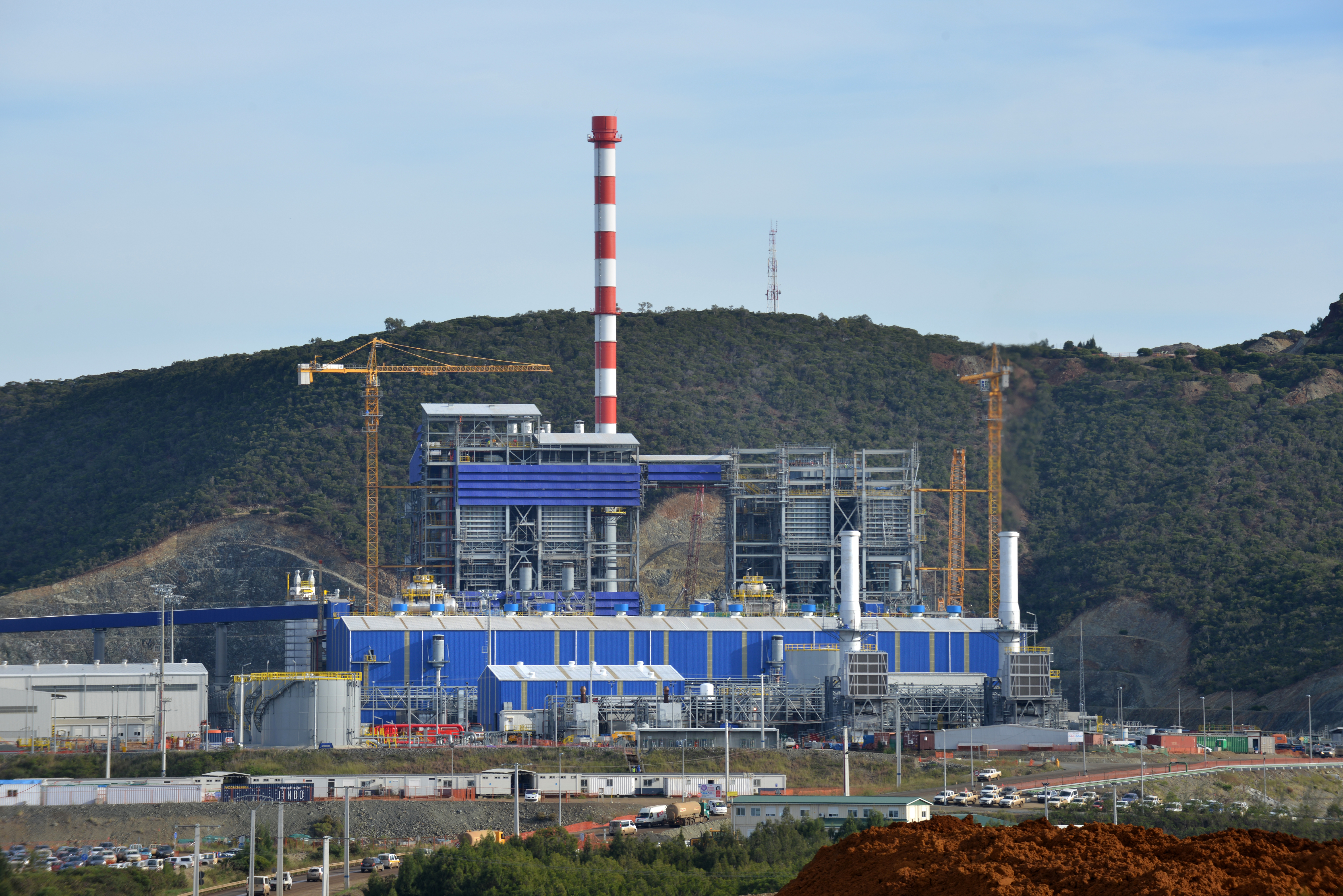Ouaco is the history of SMSP once a property of the LAFLEUR family that ran near a mining area belonging to SLN which it is lessee until 2000. The Ouaco’s village was erected in the early 1900s around the beef cannery built by Ouaco breeding company that owned the largest herd of New Caledonia over a huge area of several thousand hectares. After acquiring the Company Ouaco, Henri LAFLEUR embarks on mining on Ouazanghou then Taom massive on 1969, operating SLN concessions. Most families who had settled in the village and worked in farming remained there by adapting to the new use of the site. So SMSP was formed in 1969 when the LAFLEUR family wanted to appeal to new shareholders. SOFINOR bought SMSP and the whole town in 1990 after the signing of the Matignon Accords, and continued mining activity for the benefit of SLN and foreign export customers.
SMSP is a company producing and exporting nickel ore up in October 2008, when it made its debut in metallurgy with the commissioning of its SNNC plant based in South Korea. Thanks to an unprecedented strategy to develop the mineral resources for the benefit of the country and future generations, and innovative financial arrangements that it has been able to negotiate with international partners, SMSP owns 51% of two world class metallurgical plants. Its main mission is to enable economic rebalancing by contributing to economic development in the Northern Province.

SOFINOR TAKEOVER OF SMSP
• A vulnerable small mining company
When SOFINOR acquired the SMSP, it was operating as a « piecework company » with no mining estate of its own, paying royalties to Société Le Nickel (SLN) to mine deposits belonging to SLN. From the commercial point of view, this initial handicap was aggravated by the lack of direct sales channels, forcing the company to pay commission to intermediary traders and local export companies to deliver its ore to Japanese smelters. This meant an overall deduction of around 20% from turnover. The operation was profitable during the nickel boom but the first lasting slump in nickel prices on the London Metal Exchange (LME) spelt disaster for the company. In 1990, SMSP made a turnover of 1.2 billion XPF by exporting 309,000 tonnes of mineral ore. At that time, the company only had three years’ worth of reserves and employed a staff on 120 for deliveries to SLN and ore exports.
• Economic climate: the recession years
The first years of the 1990s were marked by the slump in world nickel prices on the LME. There was a sharp fall from 4 US$ a pound in 1990 to 2.4 US$ a pound by 1994. In conjunction with a weak dollar and a slump in demand, the sales price per tonne of mineral ore was considerably lower than the cost of producing it. The combination of every possible factor of market stagnation created a highly unfavourable context for all mining industry professionals. Following its takeover, to ensure its survival in this hostile economic environment, SMSP immediately set about implementing a strategy of reconstruction, consolidation and development.
RESTRUCTURING AND DEVELOPMENT STRATEGY
• Developing trade relations
The group’s strategy is to develop and source new clients while reducing commissions paid to intermediary traders. Since 1991, SMSP has been securing access to direct export channels to foreign smelters. Gradually, commissions paid to intermediaries (traders and local export companies) were eliminated. Concurrently, SMSP has worked to build a climate of confidence with smelters by supplying them with good quality mineral ore and signing long term contracts.
• Building a mining estate
SMSP group strategy is to build its own mining capital and to ensure the durability of its trade relations and investment policy by uncovering new mineral reserves.
The company systematically acquires the mines it operates. Debt servicing is therefore offset by eliminating royalties in respect of leasing rights. An extensive prospecting program has succeeded in bringing to light 20 million tonnes of workable reserves. Updated annually, they ensure that production is guaranteed over a ten year period. In order to conserve its resources, SMSP has ceased highgrading its deposits and called a halt to sales of high grade mineral ore (2.8%) to SLN.
• Modernising equipment
With the creation of Nord Industrie Service (NIS) in 1991, the SMSP group acquired a subsidiary dedicated to the procurement, marketing and maintenance of industrial plant. This facility ensured that equipment resources were put to more efficient use and reduced subcontractor requirements. Equipment reserves were therefore extensively renewed at the same time as a rational method of procurement management was implemented.
RAMP UP OF A MINING COMPANY
• A modest mining concern come of age
At the end of 1994, LME nickel prices began to recover reflecting a rise in global demand. SMSP had forecast this upturn in the market and possessed enough reserves and technical capacity to meet the sharp increase in demand.
The company ramped up production to double its exports between 1994 and 1995. SMSP then exceeded the 2 million tonnes mark, enabling New Caledonian nickel to recapture 50% of the Japanese market and 66% of the Australian market in laterites. At this time, the company was exporting the equivalent of 40,000 tonnes of nickel metal and 750 tonnes of cobalt a year.
• An established mining company
By the end of 1995, the company had multiplied its 1990 level of exports by seven and SMSP had become New Caledonia’s leading mineral ore exporter. The company’s export volume made it the second largest producer of oxidised ores. Company activity created around 1000 direct and indirect jobs and the company was operating mining centres on both the East and West Coasts of New Caledonia’s Main Island.
•Satisfactory trade relations
On the sales and marketing front, SMSP had managed to establish clear rules rooted in the relationship of mutual confidence existing between the company and the smelters. The Japanese smelters guaranteed a purchase price corresponding to 25% of the LME cash nickel price per pound. The company’s Australian clients, with a monopoly on the purchase of laterite ore, only paid 10% of the LME official price.
TRANSFORMATION AND A NEW PARTNERSHIP
SMSP has entered into a new era through its transformation from mining company to smelting company. To revitalise its mining capital, SMSP has acquired majority holdings in mining and metallurgy assets.
• The limitations of mining
While SMSP is clearly a powerful economic force for the North Province and for New Caledonia as a whole, mining cannot by itself produce an economic miracle for the region and stop the population drift to Noumea. Given its scattered (and necessarily ephemeral) operating activities, the mining industry cannot, by itself, create the urban pole needed to provide the North Province with its own internal economic dynamics.
• Launching economic activity
Generating 1,000 direct jobs and 2,500 indirect and induced jobs during its operational phase, the implementation of an ore processing plant ensures the launch of significant economic activity in the North Province and also ensures a local market outlet for existing manual activities (crop farming, fishing, stockbreeding, hotels and catering…). The implementation of such a major project also justifies the technical and social infrastructures required to ensure the region’s smooth and sustainable development. The SMSP Group’s economic success, its mining expertise and its assured place in the global economy helped to convince North Province leaders and elected representatives that it was time to set a new target: ore processing in New Caledonia.
• Finding a new partner
In 1994, SMSP started looking for a partner amongst the ranks of the world’s leading metallurgical companies. Although New Caledonia possesses mining expertise and resources in abundance, no New Caledonian mining company possessed the technology and financial resources to become a metallurgist unaided. The SMSP Group found in Falconbridge, at that time ranking third in the world, a metallurgy company with proven technological know-how. The Canadian corporation was open to the idea of joint venture partnerships with local operators and was interested in setting up a joint venture with SMSP. And so began a partnership which was officially announced in April 1998 by André DANG VAN NHA and Oyvind HUSHOVD.
• A worthy partner
Falconbridge was then one of the world’s foremost producers of nickel, copper, cobalt and platinum-group metals at a very competitive operating cost. It was also a major global recycling and scrap metal processing company. One of Falconbridge’s key commitments is to developing profitable, sustainable, Formatted: English (United States)Formatted: English (United States)Formatted: English (United States)
safe and environmentally friendly mining operations to promote the interests of the communities where it operates, its employees and shareholders.
• A balanced partnership agreement
The SMSP Group has a 51% stake in the KNS joint venture. Its contribution consisted of the Koniambo ore deposit, its professional expertise and its local knowledge and reputation. With a 49% stake in the joint venture, its partner contributed the feasibility studies, it guarantees both the financial investment taken on by the joint company and the construction.
This decade was marked by the finalization of the two partnership agreements, institutional and administrative approaches and launching major construction of both plants KNS, at Vavouto and SNNC, at Gwangyang. A decisive period of SMSP, which not only marks the completion of construction work but especially the release and inaugurations of metallurgical plants.
• Finalization of agreements, change of partners and review of costs for the onshore plant
In August 2006, Xstrata Nickel is the new partner of the Koniambo project after absorption of Falconbridge. In September, the partners began a renewal phase of agreements including review of costs, the redefinition of the strategy and the implementation schedule. After review and validation of the findings of the final report of the renewal phase by both boards of directors of both partners, the latter conducted December 27, 2007 the signing of the project agreement with the announcement of an amount investment of 3.8 billion USD, revised in 2011 to 5 billion USD. In February 2008, the French government has granted tax approval decision in accordance with the tax assistance device for investment overseas (the “Loi Girardin”). In May 2013, a month after the celebration of the first metal casting KNS, Glencore PLC became the new partner SMSP replacing Xstrata following the merger Glencore / Xstrata. In August 2014, a further increase in costs was announced with 7 billion USD.
• Creation of subsidiaries and transfer of mining rights for offshore plant
Following the signing of the MOA by POSCO and SMSP in February 2006, both partners have completed the creation of two new companies NMC, a mining company based in New Caledonia and SNNC a metallurgical plant based in South Korea. The Assembly of the Northern Province in October 2007 authorized the transfer of SMSP mining titles to NMC. This decision will be subject to a law passed in the country in February 2008, and allowing the transfer of assets without SMSP taxation of capital gains. The construction of the Gwangyang plant cost 352 million USD. Three years after the commissioning of the SNNC plant, the two partners decided in August 2011 to proceed with the expansion of the Gwangyang plant for a production estimated cost of 60 million USD. The new facilities allow SNNC to increase its annual production capacity of 30,000 to 54,000 tonnes of nickel metal contained in ferronickels.
• Launch and completion of the big building work
The Gwangyang plant construction work began in June 2006. The plant was built on an industrial complex that already has all the necessary infrastructure, an international port, power plant, roads, land conveyors, which helped to significantly reduce investment costs. Société du Nickel de Nouvelle-Calédonie et Corée (SNNC), which SMSP holds 51% stake, has been built in less than 30 months, went into production on October 20, 2008 and marking the entrance to the SMSP in reserved area of metallurgy. SNNC officially inaugurated Monday, November 3, 2008 and reached its nominal capacity a year later in October 2009.
As for KNS project in March 2007, the partners launched the first construction works including site access, site servicing (water, energy, etc.) construction offices, and phase 1 of the basic life. Vavouto channel excavation works began in August 2008. The construction works of the first production line were completed in December 2012 and KNS celebrated the first nickel tapping in April 2013 and those of the second line completed with a first nickel tapping in February 2014. The Koniambo Nickel plant was inaugurated the November 17, 2014 by François Holland, President of the French Republic. Installed near Koné, the capital of the Northern Province of New Caledonia, Koniambo Nickel is the main provincial development engine and offers outstanding opportunities for local communities to build their own future, that of the Northern Province and the whole country. At the peak of the construction phase, about 5,400 workers working on site. On operation phase, the company has created 907 direct jobs and 450 indirect jobs (sub-contractors on site) and about 2,500 indirect jobs. 80% of Koniambo Nickel employees are Caledonian. Northern plant construction has already generated significant economic development in the Northern Province in general and for the VKP area (common Voh, Koné and Pouembout) in particular, and that, as evidenced by the residential and commercial construction as well as recreational and community development initiatives.
• New partnership with the Chinese number 1
In February 2012, André Dang, SMSP President and Paul Néaoutyine, President of the Northern Province met in Sydney with the leader of the Jinchuan Group, Yang Zhiqiang, accompanied by his delegation. Discussions focused on the birth of a partnership agreement to develop laterite ore Caledonian. Negotiations visibly progressing, the project appears on track, “the market is there,” explained the elected separatist during its descent of the aircraft. The project provides for the SMSP and Jinchuan, China’s number one nickel, copper and cobalt, third largest producer of “green gold”, form an industrial and commercial partnership by establishing two joint ventures in New Caledonia and China, both controlled at 51% by SMSP and 49% by the metallurgist of the Middle Kingdom. Posco project has proven and could attract Chinese interlocutors. Early 2013, SMSP and the Chinese Jinchuan Group form the joint venture: Caledonian Chinese Mining Company SAS is headquartered in Noumea, 51% owned by SMSP and having to subject all operations related to mining.




